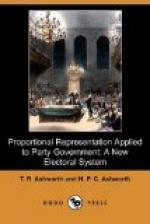This evil would also be entirely removed. Every vote cast would count to one or the other party. It is not necessary that every vote should be counted to some one candidate, as the advocates of the Hare system claim. Votes given to rejected candidates would be in effect just as much transferred to the successful candidates as by the Hare system. Moreover, it is an important gain that the candidates of each party would be ranged in order of favour, as the relative position of the candidates would be an index of the feeling of each electorate, not only as regards men but also as regards measures. Therefore, even the votes given to rejected candidates would affect the framing of the party policy, and show the progress of public opinion.
+Uncontested Seats.+—At the 1895 election for the Imperial Parliament no less than 189 seats out of 670 were uncontested. Thus one-quarter of the people had no opportunity of expressing any opinion. In Australia the proportion is often quite as large. The present Legislative Council of Victoria is an extreme instance. One-third of the Council retires every three years; and at the last election not a single seat was contested. Only 4 out of the 48 sitting members have had to contest election. Under these circumstances the holding of an election at all becomes a farce. No doubt it is very convenient for the favoured individuals; but as the primary object of elections is the ascertainment of public opinion, it is very desirable that every seat should be contested.
The chief cause of this evil is that when one party is strong in an electorate it is hopeless for the minority to contest it, unless the majority nominates more than one candidate. On the other hand, the majority knows that if it does split its votes the minority will probably win the seat. The result is that the sitting member has a great advantage, and is often tolerated even though he is acceptable to only a minority of his own party.
With the reform each electorate would become the scene of a contest between the two parties for their proportional share of representation. It is very unlikely, indeed, that in any electorate no more candidates would be nominated than are required to be elected.
+Limitation of Choice.+—Even when seats are contested, the elector’s choice is very limited under the present system. Wherever party government is strong, each party nominates only one candidate, owing to the danger of splitting up its votes and so losing the seat. The elector has then practically no choice. He may disapprove of the candidate standing for his own party, but the only alternative is to stultify himself by supporting the opposing candidate. If in disgust he abstains from voting altogether, it is the same as giving each candidate half his vote. Even when two or three candidates of his own party are nominated, and he supports the one whose views coincide most closely with his own, he can exert very little direct influence on the party policy. Besides, he will often think it wise to support the strongest candidate rather than the one he favours most.




